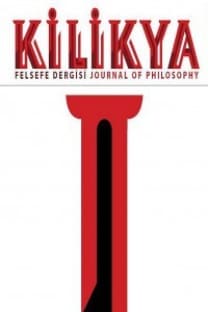Tıp Etiğinden Bio-Etiğe: Fritz Jahr
Tıp etiği, biyoetik, Fritz Jahr, yaşama saygı, bio-ethics
From Medical Ethics to Bio-Ethics: Fritz Jahr
Medical ethics, bioethics, Fritz Jahr, reverence for life, bio-ethics,
___
- Aristoteles (2005). Nikomakhos’a Etik (S. Babür, Çev.). Ankara: Kebikeç Yayınları.
- Aşar, H. (2017). İnsan-Merkezcilik Canlı-Merkezcilik İkileminde Biyoetik. Türkiye Biyoetik Dergisi, 4(2), 74-86. Doi: 10.5505/tjob.2017.07078
- Aşar, H. (2018). Hayvan Haklarına Yönelik Temel Görüşler ve Yanılgıları. Kaygı, 30, 239-251. Doi: 10.20981/kaygi.411236
- Baron, J. (2006). Against Bioethics. Cambridge: The MIT Press.
- Beauchamp, T. L. (2010). Standing On Principles. New York: Oxford University Press.
- Büken, N. Ö. & Büken, E. (2002). Nedir şu “Tıp Etiği” Dedikleri? Sürekli Tıp Eğitimi Dergisi, 1(11), 17-20.
- Engelhardt, H. T. (2012). A Skeptical Reassessment of Bioethics. H. T. Engelhardt (Ed.), Bioethics Critically Reconsidered Having Second Thoughts içinde (ss.1-30). New York: Springer.
- Engels, E-M. (2011). The Importance of Charles Darwin‘s Theory for Fritz Jahr‘s Conception of Bioethics. JAHR- European Journal of Bioethics, 2(4), 475-504.
- Eterovic, I. (2011). Kant’s Categorical Imperative and Jahr’s Bioethical Imperative. JAHR- European Journal of Bioethics, 2(4), 457-474.
- Evans, J. C. (2005). With Respect for Nature Living as Part of the Natural Word. Albany: State University of New York Press.
- Hartmann, F. (2000). Hekimlik Eyleminde Etik Gerilim Boyutları. D. Engelhardt (Ed.), Tıbbın Gündelik Yaşamında Etik (A. Namal, Çev.) içinde. İstanbul: Nobel.
- Jahr, F. (2010). Bio-Ethics: Reviewing the Ethical Relations of Humans Towards Animals and Plants ( H. M. Sass, Çev.). JAHR- European Journal of Bioethics , 1(2), 227-231.
- Johnson, L. E. (1991). A Morally Deep World. Cambridge: Cambridge University Press.
- Kalokairinou, E. M. (2016). Fritz Jahr’s Bioethical Imperative: Its Origin, Point, and Influence. JAHR- European Journal of Bioethics , 7(4), 149-156.
- Kant, I. (2002). Ahlak Metafiziğinin Temellendirilmesi (İ. Kuçuradi, Çev.). Ankara: Türkiye Felsefe Kurumu Yayınları.
- Kant, I (1997). Lectures on Ethics (P. Heath, Çev.). Cambridge: Cambridge University Press.
- Kant, I. (1991). The Metaphysics of Moral (M. Gregor, Çev.). Cambrdige: Cambridge University Press.
- Leopold, A. (1966). A Sand County Almanac. New York: Ballantine Books
- McCullough, L. B. (2012). Bioethics and Professional Medical Ethics: Mapping and Managing an Uneasy Relationship. H. T. Engelhardt (Ed.), Bioethics Critically Reconsidered Having Second Thoughts içinde (ss. 71-84). New York: Springer.
- Reich, W. T. (1995). Introduction. W.T. Reich (Ed.), Encyclopedia of Bioethics içinde. New York: Macmillan.
- Rolston, H. (2003). Environmental Ethics. N. Bunnin & E. P. Tsui-Jamess (Ed.), The Blackwell Companion to Philosophy içinde (ss. 517-531). Malden: Blackwell Publishing.
- Sass, H. M. (2009). Asian and European Roots of Bioethics: Fritz Jahr’s 1927 Definition and Vision of Bioethics. Asian Bioethics Review, 1(3), 185-197.
- Schweitzer, A. (1923). The Philosophy of Civilization (C. T. Campion, Çev.). Buffalo: Prometheus Books.
- Singer, P. (2002). Animal Liberation. New York: Ecco Press.
- Taylor, P. W. (Fall 1981). The Ethics of Respect for Nature. Environmental Ethics 3(3), 197-218.
- Taylor, P. W. (2011). Respect for Nature: A Theory of Enviromental Ethics. New Jersey: Princeton University Press.
- Topakkaya, A. (2013). Hans Jonas’ta İnsan ve Doğanın Değeri. FLSF, 15, 41-52.
- Veatch, R. M. (1995). Codes of Medical Ethics: Ethical Analysis. W.T. Reich (Ed.), Encyclopedia of Bioethics içinde (ss. 172-180). New York: Macmillan.
- Yayın Aralığı: 2
- Başlangıç: 2014
- Yayıncı: Eray Yağanak
Kant’ın Opus Postumum Adlı Yapıtında Geçiş Sorunu
Wittgenstein’ın Birinci Dönem Düşüncelerindeki Resim Kuramı ve Anlamla İlgili Sorunlar
Pyrrhus ile Cineas’ta Tasarı ve Aşkınlık Temelinde Simone De Beauvoir’ın Carpe Diem Eleştirisi
İnsan, İnsancıllık (Hümanizm) ve İnsan Hakları: İnsancıllık Eleştirisi Üzerine
İnsan Etkinliğinin Doğası: Arendt’in Marx Üzerine Görüşlerinin Eleştirel Bir Değerlendirmesi
Kierkegaard’nun Öznel-Nesnel Hakikat Ayrımı Temelinde Tekil Birey Anlayışı
Tıp Etiğinden Bio-Etiğe: Fritz Jahr
G. W. F. Hegel’in Estetik Üzerine Dersleri ve Sanatın Sonuna İlişkin Tezler
